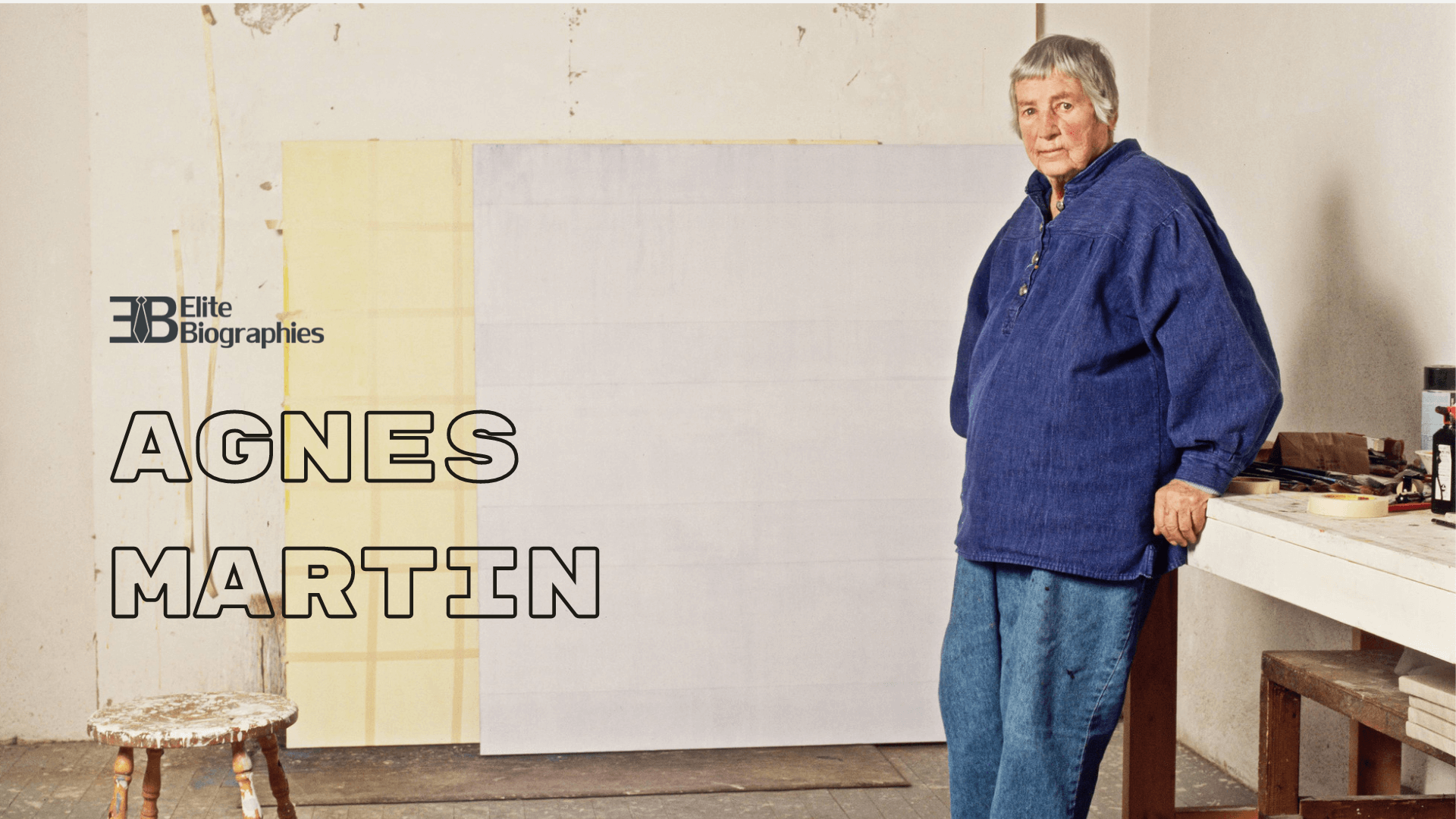Agnes Martin

Agnes Martin was a Canadian-born American abstract painter renowned for her serene and subtle works. Her minimalist style has made her an influential figure, particularly in the development of minimalist art.
Early life
Agnes Bernice Martin, born in 1912 in Macklin, Saskatchewan, was the daughter of Scottish Presbyterian farmers and one among four siblings. She spent her formative years in Vancouver from 1919 onwards. In 1931, she relocated to the U.S. to support her expectant sister, Mirabell, in Bellingham, Washington. Preferring the quality of American education, she obtained her American citizenship in 1950. Her educational journey included studying at Western Washington University College of Education in Bellingham, Washington. She later earned her B.A. in 1942 from Teachers College at Columbia University. During her time in New York, she became fascinated with modern art, drawing inspiration from artists like Arshile Gorky, Adolph Gottlieb, and Joan Miró. At Teachers College, she actively engaged in multiple studio classes, laying the groundwork for her future artistic career.
In 1947, Martin attended the University of New Mexico’s Summer Field School in Taos. Inspired by lectures from the Zen Buddhist academic D. T. At Columbia, she grew fond of Asian philosophies. These philosophies, which she saw as practical guidelines for life, didn’t become religious beliefs for her. After a few post-graduation years, Martin joined the University of New Mexico in Albuquerque, both as a student and art instructor. She then returned to Columbia University, securing her M.A. in modern art by 1952. In 1957, she settled in New York City, residing in a loft at Coenties Slip in lower Manhattan, a neighborhood shared with several artists. While each artist had distinct styles, the sense of community was palpable. The area also served as a sanctuary for the LGBTQ+ community during the 1960s. Speculations hint at a possible romantic relationship between Martin and artist Lenore Tawney during this period.
Agnes Martin, an avant-garde of her era, remained private about her sexuality. However, she’s often referred to as a discreet homosexual. The biography titled “Agnes Martin: Pioneer, Painter, Icon” from 2018 sheds light on her romantic involvements with various women, notably with the art dealer Betty Parsons. She frequently used a feminist perspective when evaluating the works of her peers. Art historian Jaleh Mansoor even remarked that Martin was profoundly influenced by feminist practices, although she never labeled them explicitly. Interestingly, Martin did not self-identify as a feminist, and she once shared with a New Yorker reporter her belief that the women’s movement had not succeeded.
Career
Martin began her artistic career as an educator, teaching in public schools and universities. Her painting style evolved over time, gradually moving towards abstraction. In the late 1950s and 60s, she became associated with the Abstract Expressionist movement in New York. During this time, her work was primarily focused on geometric shapes, grids, and lines, often infused with a quiet spirituality.
In 1967, she left New York and moved to New Mexico, where she continued to develop her minimalist aesthetic. Her work often incorporated soft colors and hand-drawn lines that created a sense of calm and introspection. Throughout her career, she exhibited in several prominent galleries, such as Betty Parsons, Pace, and the Whitney Museum of American Art.
Her art is deeply linked to Taos, with evident influences from the New Mexico desert landscape in her initial creations. Yet, her childhood in the expansive, tranquil prairies of Saskatchewan, Canada, equally resonates in her work. Although she identified as an American artist, Martin’s connection to her Canadian heritage remained intact. She revisited Canada after departing New York in 1967 and during her widespread travels in the 1970s. Some have likened Martin’s earlier pieces to basic agricultural fields. Martin welcomed diverse interpretations of her work, often drawing parallels between her minimalistic, single-tone canvases and natural landscapes.
Martin’s art often defied categorization, and she insisted that her work was about emotions and experiences rather than representing any specific image. She continued to create art into her 90s, contributing to her reputation as an enduring figure in the art world.
Martin’s artistic vision and dedication have left an indelible mark on the world of abstract art. Her unique approach to minimalism and her lifelong commitment to exploring the emotional experience of art continues to resonate with audiences and inspire artists today.

Net Worth
Though the exact details of Martin’s net worth are not publicly disclosed, her artworks have fetched high prices at auctions and private sales. Her net worth was estimated between $10-12 million.
Achievement
Agnes Martin’s achievements are numerous, reflecting her significant contribution to the field of abstract art. Here are some highlights:
Films about Martin:
- 2000: On a Clear Day – Agnes Martin by Thomas Luechinger. Documentary, 52 minutes.
- 2002: Agnes Martin: With My Back to the World by Mary Lance. Documentary, 57 minutes.
- 2002/2016 (re-edited): Agnes Martin: Between the Lines by Leon d’Avigdor. Documentary, 60 minutes.
- 2016: Agnes Martin Before the Grid by Kathleen Brennan and Jina Brenneman. Documentary, 56 minutes.
Social Profile
Agnes Martin was known for her reclusive nature and rarely engaged with the media or social platforms.